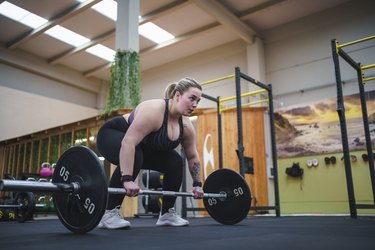
If you've been lifting weights for a while and are looking for a new challenge, you might want to give powerlifting a try.
Powerlifting is a weightlifting sport that consists of three lifts: the squat, bench press and deadlift. It was first an organized sport with a world championships in 1964, held in York, Pennsylvania, according to the International Powerlifting Federation (IPF). The goal? To see who can lift as much weight as possible for one rep of each move.
Video of the Day
Video of the Day
However, powerlifting involves more than just that — you must also compete within a weight class. As the name suggests, your weight determines which category you fall into. Powerlifting is divided up into weight classes so that a 130-pound person isn't competing against a 250-pound person, for example.
Weight classes remain basically the same for men and women, but women have lighter classes and men have heavier classes. In the middle weight categories, the classes are identical.
Below, we'll go through everything you need to know about the weight requirements of powerlifting so you're armed with all the knowledge you need if you want to get into the sport.
A Quick Note on Language
Here at LIVESTRONG.com, we carefully consider language surrounding sex and gender. We typically avoid language that implies a sex or gender binary in favor of inclusive language. However, the IPF categorizes weight classes into "men's" and "women's," so we've used those terms below.
Men's Classes in Powerlifting
Below are the men's powerlifting weight classes, according to the 2023 IPF Technical Rules Book. The IPF lists them in kilograms (kg), but we've also listed the men's powerlifting weight classes in pounds.
Most competitors climb several weight classes for powerlifting over the course of their competitive years. This is due to both the nature of powerlifting training, which promotes muscle growth, and the fact that powerlifters spend far more time building strength and less time building muscle than bodybuilders.
Men's Powerlifting Weight Classes
53 kg/116 lbs |
59 kg/130 lbs |
66kg/145 lbs |
74kg/163 lbs |
83 kg/182 lbs |
93 kg/205 lbs |
105 kg/231 lbs |
120 kg/264 lbs |
120+ kg/264+ lbs |
Women's Weight Classes in Powerlifting
Below are the women's powerlifting weight classes, according to the 2023 IPF Technical Rules Book. The IPF lists them in kilograms (kg), but we've also listed the women's powerlifting weight classes in pounds.
Women's Powerlifting Weight Classes
43 kg/94 lbs |
47 kg/103 lbs |
52 kg/114 lbs |
57 kg/125 lbs |
63 kg/ 138 lbs |
69 kg/152 lbs |
76 kg/167 lbs |
84 kg/185 lbs |
84+ kg/185+ lbs |
Making Weight
Each weight class, with the exception of the unlimited class, has an upper limit. The men's 116-pound class will have no one in it weighing 116.5 pounds. Anyone over 116 pounds must lift in the next category.
Weigh-in to figure out which weight class you're competing in can occur anywhere from 24 to 48 hours before a meet in some competitions, to only two hours before a meet for International Powerlifting Federation championship meets, per the IPF. The longer the time between weigh-in and competition, the easier it is to make weight.
Strength-to-Weight Ratio in Powerlifting
Your strength-to-weight ratio is your strength divided by your body weight.
Using established records as the limit and the top weight for each class, men can lift 8.9 times their bodyweight on average when setting a world record. The highest ratio is in the lightest weight class, where Andrzej Stanaszek of Poland achieved 10.6 times his bodyweight, according to Powerlifting Watch, a popular powerlifting publication. The lowest ratio is in the heaviest weight class, where John Cole of the U.S. totaled 7.7 times his bodyweight in competition.
Women can lift a total of 6.8 times their bodyweight when setting a record. Unlike men, for women the highest ratio is in the middle-weight class, where Carrie Boudreau of the United States totaled 7.6 times her bodyweight, according to Powerlifting Watch. Like the men, the women's lowest strength-to-bodyweight powerlifting total occurs in the heavyweight class, where Shannon Nash of the U.S. totaled 6 times her bodyweight.